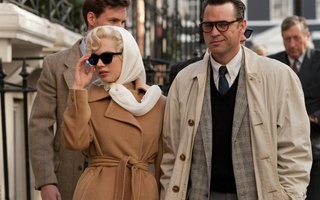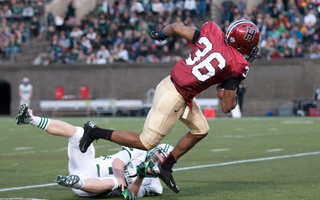In Andrew O’Hagan’s “The Life and Opinions of Maf the Dog, and of His Friend Marilyn Monroe,” there is a memorable scene that takes place in Alfred Kazin’s luxurious Riverside Drive apartment. In a lovely but reductive caricature of the New York intellectual circuit, Maf, Monroe’s white Maltese—a self-professed Trotskyite—watches the men of the Partisan Review take each other’s ideas to task as their forgotten wives cower in the corner. Meanwhile, a young “girl of eager solemnity” named Susan (Sontag, perhaps?) expounds on the “cascade of pensées” she intends to write.
Monroe, soaked in Chanel No. 5, has withdrawn to Kazin’s bedroom to discuss psychiatrist Sigmund Freud’s essay “Dostoevsky and Parricide” with Irving Howe and Lionel and Diana Trilling. The elegant intellectuals and the sumptuous actress engage in a somewhat reflexive conversation that outlines what seems to be the novel’s project.
Praising Dostoevsky’s refusal to spare anyone in his novels, the character of Irving Howe suggests that the present dearth of comic novels results from an inability of the modern novelist to conceive of ‘the pícaro,’ a character who, just like Maf, is “defined by his energy and his voice,” moving “from adventure to adventure, each cluster of incidents bringing him into a relation with a new set of characters.” All great stories, Howe continues, are about the servants: “King Lear” is really about the fool, and “The Brothers Karamazov” is really about Smerdyakov.
In this little ‘play within a play,’ O’Hagan presents his latest book as an attempt to fill that void, to write such a comic novel in an age that seems to have abandoned the genre altogether. Like the picaresque comedies of Cervantes and Henry Fielding, O’Hagan’s story even has its own ‘pícaro,’ in the character of Maf, a typical roguish outsider who enters either a corrupt or bizarre society only to skewer it with his cunning and humorous observations. And in the case that none of that becomes apparent in the text itself, O’Hagan goes so far as to title his meditation “The Life and Opinions of Maf the Dog, and of His Friend Marilyn Monroe,” a clear allusion to Laurence Sterne’s “The Life and Opinions of Tristram Shandy, Gentleman.”
The problem with “The Life and Opinions of Maf the Dog,” however, is not its aggressive self-presentation as such a comic novel; at times, O’Hagan’s narrative is indeed a clever outsider’s portrayal of the ultimate insider’s world. The problem, rather, is that O’Hagan’s obsession with his chosen genre seems to inhibit any substantive portrait of Marilyn Monroe whatsoever. There is no reason that the psychology of a cultural icon of Monroe’s stature need be ignored for what O’Hagan seems to believe constitute the conventions of the comic novel: the two are not mutually exclusive, and the novel suffers from its highly superficial and unexamined portrait of Monroe herself. Often, it even seems as though she exists merely to grant Maf access to some of the sorts of social circles he can criticize, admire, or attack. And there are many.
In a remarkable feat of name-dropping, O’Hagan starts with the vestiges of the Bloomsbury Group on the estate of Vanessa Bell, where Natalie Wood and her mother discover Maf. He then continues on to Los Angeles, where Wood’s mother sells him to Frank Sinatra, who then flies the dog across the country to deliver to the recently divorced Monroe, newly ensconced in her Sutton Place apartment. From then on, in addition to Kazin, Howe, and the Trillings, we meet Allen Ginsberg, Carson McCullers, Peter Lawford, and, of course, President John F. Kennedy ‘40. All that happened between Monroe and the President, according to Maf, was an intense conversation. “Don’t hold your breath for stunning revelations,” he cautions.
The result, of course, is that Monroe herself cannot be considered anything more than a plot device that enables her dog to witness some of the 20th century’s most interesting conversations. Perhaps the novel would be more substantive if Maf explored the psychology or the ideas of the famous faces he encounters rather than being distracted by their celebrity. This, in a sense, is the novel’s great weakness; for comic effect, O’Hagan’s novel celebrates the aura of Marilyn’s celebrity without addressing the necessary questions that such a celebrity inspires.
It hardly needs to be said that Monroe was a fascinating character. Christened Norma Jeane Mortensen, she transformed herself into an object of male desire, became a cultural artifact with celebrity that came to inhabit her entire identity, and fell into a depression that ultimately ended with her suicide in 1962. As any reader of Joyce Carol Oates’s “Blonde” can attest, much can be done with such a complex figure. But in O’Hagan’s novel, where is Monroe’s transformation? Where is the effect of her celebrity on her psychology? Where is her descent into mental illness?
Of course, it could be argued that this novel is not exactly about Marilyn Monroe in an explicit sense and is instead a portrait of her cultural milieu. However, regardless of O’Hagan’s focus, it seems irresponsible to ignore Monroe’s interiority, given his plot’s reliance on her life and her social circles.
Of course, O’Hagan is quick to include the cliché of Monroe as a good girl victimized by the drooling glances of men; according to Maf, “it was as if the world had bleached her with attention.” His mistress, he continues, “wanted to learn to be taken seriously, to value her experience. And yet she was hitched to the person she had always been: the girl who was sweet and available, who now took pills and drank.”
These meditations aside, there is little in the novel that addresses the depth of Monroe’s character, or the toll her celebrity took on her person. Of her psychological disarray, Maf only confesses in passing he “can’t pretend that I ever truly understand what ailed my owner; it was the human thing, that burden of self-consciousness that weighs down the day.” Because O’Hagan’s novel cannot avoid addressing Monroe’s death, “the human thing” is just not enough to explain her depression or her mysterious end. Once she checks into a psychiatric clinic, any interpretation is passed over for yet another moment of mental masturbation. Maf ruminates on Virginia Woolf and her dislike for James Joyce, saying only of Monroe that she lay distraught, “dreaming of her father.”
Even if “The Life and Opinions of Maf the Dog” does not quite fulfill its potential, its caricatures have their occasional entertaining moments. But the comic novel needn’t be caricature alone, and O’Hagan’s failure to overcome such superficiality leaves the reader wondering not what his novel achieves but rather what it might have been.
—Staff writer James K. McAuley can be reached at mcauley@fas.harvard.edu.
Read more in Arts
Glitz and Glamour Fail to Conceal Shortcomings of SpeakEasy's 'Nine'Recommended Articles
-
Notice.LOST.- Yesterday from the Carey Building, a very heavy, plain, yellow varnished bat. Please return to Enright the janitor before
-
DEBATING UNION TO HOLD FIRST MEETING TUESDAYThe first meeting of the Debating Union will be held at the Harvard Union next Tuesday evening at 7.30 o'clock
-
MONROE TO BE ACTING MASTER OF KIRKLANDArthur E. Monroe '08, lecturer and tutor of Economics, was yesterday named by the University to replace Walter E. Clark
-
 Complicating Marilyn Monroe
Complicating Marilyn Monroe -
 Monroe ’13 Remembered for Charisma On and Off the Field
Monroe ’13 Remembered for Charisma On and Off the Field













